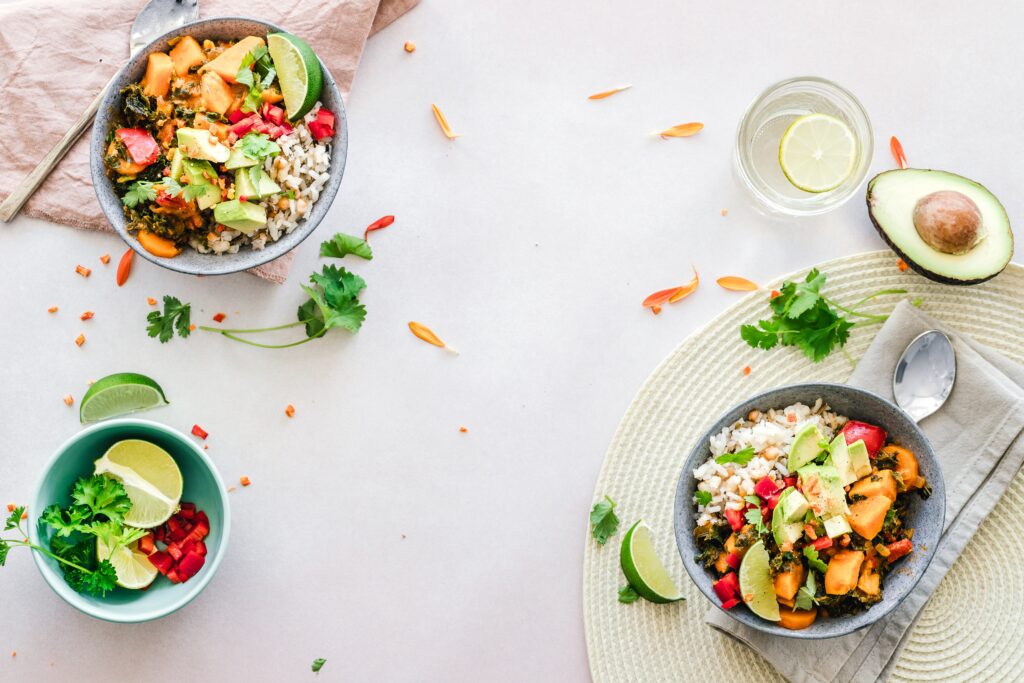While January is an invigorating month, it’s also easy to feel less than stellar come the new year (hello, post-holiday hangover). In many ways, this is why diet culture sells. We’re marketed new year, new you messages—the promise that if you change your diet or your weight, you’ll be exponentially happier. Been there, got roped into that. Fortunately, you don’t have to buy in. You can create habits for a healthy new year without sacrificing the food and experiences you love. Said differently: you can feel vibrant and nourished without going on a diet, doing intense exercise, or adhering to a restrictive lifestyle. At the end of the day, this is about finding what works for you. What foods do—or don’t—make you feel your best? What forms of exercise make you feel confident and energized? Read on to learn how to prioritize your well-being in 2023.

what is the foundation of optimal health?
When it comes to optimal health, there are a few foundational pieces to the puzzle—quality sleep, daily movement, self-care, and balanced nutrition. But of this list, nutrition is at the tippy top. After all, food fuels every cell in the body. It’s like the gas in your car. The better the fuel, the more optimal the drive (particularly in the long-run). Therefore, understanding basic nutrition concepts can make all the difference. Not sure where to begin? This meal plan is a great place to start. While we all have different nutritional needs and cravings, one thing remains universal: stable blood sugar.
All about blood sugar
Sugar—or glucose—is the body’s main source of energy. The term “blood sugar” refers to the amount of energy (sugar) present in our bloodstream at one set time. Sugar is produced when we break down food. Namely, carbohydrates. Be it a bowl of pasta or an apple, carbs are absorbed into the bloodstream. Immediately or eventually, these carbs are used as fuel. While we need carbs (they’re the body’s ideal form of energy!), they do shuttle sugar into the bloodstream. And too much sugar in your blood isn’t the goal. This can lead to everything from from a sugar high (and crash) to hormone imbalances and other conditions. Ultimately, everyone benefits from stable blood sugar—not just pre-diabetics and diabetics.

how to balance blood sugar in 2023
Good news! There are many ways you can support optimal blood sugar. These are my favorite tips: first and foremost, pair carbs with protein and / or fat. Reason being, both protein and fat help keep blood sugar levels stable. For example, enjoy an apple with almond butter and chia seeds, or a piece of sourdough toast with an avocado and hard boiled egg (rather than eat the carbs on their own). This helps slow the release of sugar into your bloodstream. Secondly, go for a stroll after a meal—even 10 minutes is great. This allows your muscles to soak up glucose, putting that sugar to great use. Last but not least, consider taking a more personalized approach and wear a continuous glucose monitor.

Want to try a continuous glucose monitor? My favorite CGMs are Nutrisense and Levels.
how do you create healthy habits in the new year?
Without further ado, below are practical habits for a healthy new year. These include everything from a balanced approach to eating to minimizing unnecessary toxins in your home. Ultimately, prioritize what best suits your circumstances, needs, and goals. And remember: an evolved, healthier version of you is only feasible if you’re excited about what you want to implement.

1. Prioritize protein
Want to feel satisfied after eating, support muscle growth, power your immune system, keep blood sugar happy, and create hormone balance? If so, say hello to protein. While carbohydrates and healthy fats are very important, protein is involved in even more key functions. Eating enough protein is the secret to a slew of health benefits: blood sugar balance, weight management, quality sleep, absorbing calcium, and even bone health. As a Nutrition Consultant, I find that a good rule of thumb is roughly 20-30 grams of protein per meal. Again, this will vary across the board (particularly if you’re pregnant). When possible, prioritize quality protein with breakfast—this will support your metabolism, lean muscle growth, and more.
2. Focus on fiber
When it comes to habits for a healthy new year, make a goal to increase your fiber consumption. In fact, it’s estimated that a whopping 95% of Americans don’t meet the daily recommended amount of fiber. Thankfully, many whole food sources of carbohydrates—like 100% whole grains, fruits, and vegetables—contain fiber. My other favorite sources of fiber are nuts and seeds (chia and flax, in particular) and legumes, like lentils. Fiber helps slow digestion and minimize blood sugar peaks. Though most carbohydrates are broken down into sugar molecules, fiber is an outlier. Instead, fiber passes through the body, undigested. In turn, it helps minimize constipation, regulates hunger cues, and reduces the glycemic index. Win, win, win.
3. aim for a balanced plate
When in doubt, create a balanced plate of food. But what does this mean? Aim for half a plate of non-starchy carbs (greens, broccoli, Brussels sprouts, bell peppers, etc.), a fist-sized amount of protein (4-6-oz), 1-2 sources of healthy fats, and a serving (1/2-1 cup) of slow-digesting carbs (oats, quinoa, sweet potatoes, etc.). While everyone’s portions will differ, these general guidelines will help steer you in a satiating direction. In essence, fill as much of your plate with non-starchy carbs, ensure you have 20+ grams of protein on your plate, and don’t forget healthy fats. Depending on your needs and goals, you may need more or less than one cup of slow-digesting carbs—particularly if you’re more insulin resistant.
4. Add Seeds
Have you heard of seed cycling? This hormone-supporting tool is one of the top trending wellness practices (and for good reason). This simple practice helps support balanced hormone levels, reduces PMS symptoms, boosts fertility, and can help stimulate menstruation—if it’s absent. Not only does alternating between flax / pumpkin and sesame / sunflower seeds aid in regulating hormones, but seeds also add more fiber, zinc, and other minerals to your diet. Micronutrients, baby. Funk It Wellness makes it easy to seed cycle.
5. Eat At Regular Intervals
This goes without saying, but aim to eat meals at regular intervals during the day. For most, that’s every 3-4 hours. Skipping breakfast—or any meal—can increase blood sugar when you finally sit down to eat. However, eating every few hours helps keep blood sugar in check by not letting it dip too low. Plus, cortisol (our stress hormone) can get out of whack with weird eating patterns, which can lead to unstable glucose levels and cause stress on the body. While this isn’t about eating constantly, it is about eating consistently. Furthermore, try to eat within an hour of waking—this is especially important for women trying to balance their hormones. The body is primed and ready to receive nutrients shortly after waking—after all, it’s been a while since you last ate, after all.
6. come prepared with snacks
Worried about the selection of food at your next outing, activity, or work event? Plan ahead of time. Ultimately, this is about giving yourself the added boost of nutrients to support your blood sugar. It’s usually easy to find carb-rich snacks (granola bars, chips, bananas, etc.), so I like to keep fat-forward or protein-forward snacks in my bag—or the car! A few shelf-stable favorites: fava beans, beef sticks, nut butter packets, and protein bars. I also always have electrolytes with me, too.
7. Manage Stress
No surprise here. Stress elevates cortisol—one of our body’s main stress hormones. This can increase blood sugar and insulin levels. And while everyday stressors are inevitable, that doesn’t mean you can’t find ways to cherish your rituals, make time for meditation, and set proper boundaries. Whether it be sticking to your budget or politely declining a boozy get-together, take care of mental health in order to support habits that make you feel well. On the flip side, maybe you need to live a little! Honoring what your body needs may also look like incorporating more spontaneity and joy into your life.
8. consider sugar alternatives
When it comes to baking your favorite sweets in 2023, opt for lower glycemic sugar alternatives. My favorites are monkfruit and allulose. They’re easy to bake with and you won’t taste the difference! Swapping refined sugar (or even maple syrup) for these alternatives can drastically improve your blood sugar response. Too much sugar is a precursor to everything from headaches and bloating to poor sleep, feeling jittery or anxious, and irritability. Of course, that doesn’t mean you always need to use a sugar alternative. Be it a special occasion or celebration, you are more than deserving of a decadent treat—and no, this treat won’t derail your habits for a healthy new year. Promise.
9. enjoy daily movement
Moderate, daily movement is beneficial for overall health—but it’s especially helpful for managing blood sugar levels, stress, and hormones. A moderately vigorous effort for 30 minutes (think: brisk walking, cycling, or strength training) can significantly benefit insulin regulation. All of that to say, a post-meal walk does wonders. Anything to get moving and grooving counts! Whether your fitness goal is to exercise a couple of times per week, you’re hoping to grow muscle and strength this year, or you want to run a marathon, it’s important that you enjoy the type of movement you choose. Otherwise, it won’t be sustainable.
10. get quality sleep
Last but not least, sleep. Did you know that 50-70 million Americans have chronic sleep issues? And as of 2014, roughly 35 percent of U.S. adults sleep less than seven hours per night? If you relate to one (or both) of these categories, you’re not alone. Make 2023 the year you actually hone in on your sleep hygiene. While being mindful of your caffeine consumption is important, consider focusing on your bedtime routine. Bedtime routines can vary, but they often include calming activities like dimming the lights, taking a warm bath, brewing a cup of herbal tea, cleansing and moisturizing your skin, reading, journaling, meditating, and using essential oils. Bedtime routines help you prepare for sleep by setting aside time to relax and calm down. And—spoiler alert—they’re the secret sauce for a healthy new year.

This article is for informational purposes only. It is not, nor is it intended to be, a substitute for professional medical advice, diagnosis, or treatment and we recommend that you always consult with your healthcare provider.



Leave a Reply